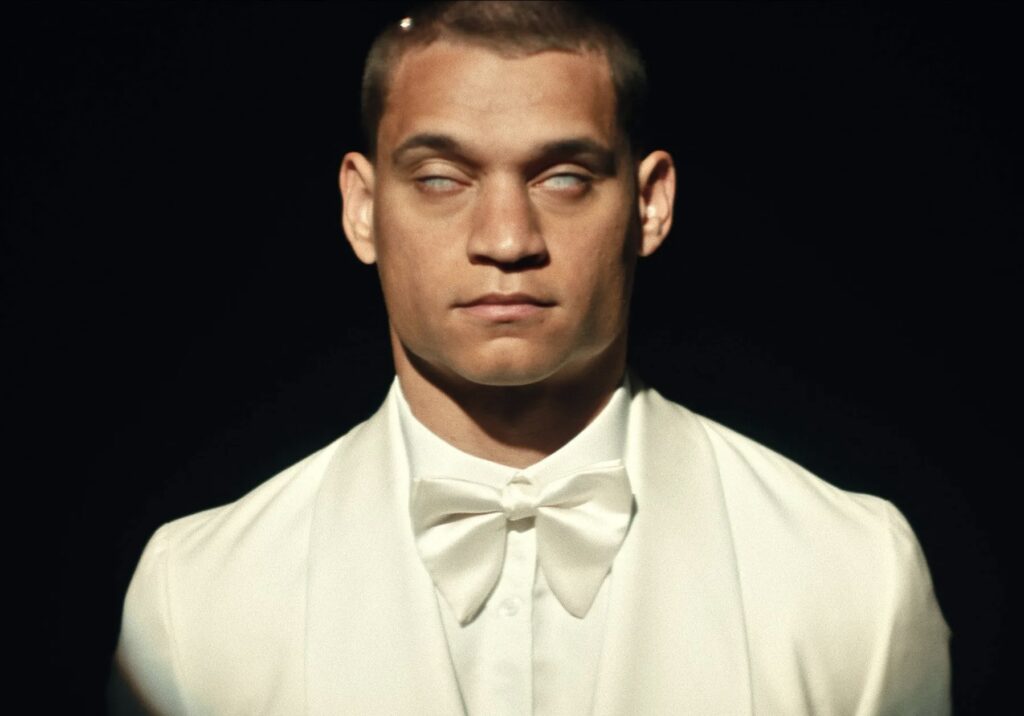Horror cinema has long relied on familiar visual cues—flickering lights, trembling close-ups, sudden camera jolts. Yet in Him, director Justin Tipping and cinematographer Kira Kelly set out to rip up the playbook, crafting an aesthetic that marries the psychological with the athletic, transforming the football field into a stage of existential dread. What they achieved is less about jump scares and more about building an entirely new vocabulary of terror—one that feels bodily, spiritual, and unrelentingly intimate.
Kelly’s approach meant not only adopting unorthodox concepts but also forging new tools. Much like a coach engineering plays for a once-in-a-lifetime athlete, she and her crew engineered visual devices designed to collapse the distance between the protagonist’s unraveling psyche and the viewer’s own nervous system. The result is a horror film that bends the conventions of sports cinema and psychological thrillers, creating a visceral fusion of spectacle and subjectivity.
The Athletic Body as Haunted Terrain
The central figure in Him is not just a football player but a vessel of mounting dread. His body, sculpted for competition, becomes a site of vulnerability. Tipping insisted that the terror of the story had to be communicated through more than narrative suggestion—it had to live in the movement, the sweat, the collisions.
Kelly explains that lighting the film required a rejection of glossy sports advertising aesthetics. Instead of vibrant stadium glows or cinematic hero shots, the team leaned into harsh contrasts, isolating the player in voidlike darkness. This created an uncanny dislocation: the gridiron no longer appeared like a communal arena but a liminal stage where reality falters. The body of the athlete, normally celebrated as indestructible, became fragile—an instrument through which paranoia and spectral visions seeped into the frame.
The white tuxedo moment—a surreal image of an athlete suspended between elegance and dread—exemplifies this tension. Here, physical perfection collides with vulnerability, and the image functions as both dream and nightmare.
New Tools for New Terrors
Traditional cinematography rarely captures interiority with such weight. Kelly and her crew had to improvise: building rigs that could move with the player’s breath, mounting cameras at unfamiliar angles, and experimenting with lenses that warped depth perception.
Some of these tools were born out of trial and error. A helmet rig, for instance, placed the audience inside the protagonist’s vision, exaggerating claustrophobia and tunnel vision. Instead of offering clarity, it blurred edges and bent lines, forcing the viewer to share in his disorientation.
Lighting rigs were equally experimental. Kelly used pulsating sources, mimicking the staccato rhythm of a heartbeat under duress. In certain sequences, the crew layered gels to fracture the color temperature, creating a disequilibrium that felt closer to a panic attack than a carefully orchestrated film sequence.
This attention to “felt” imagery—how the light and lens could approximate states of fear—demanded a re-training of the crew’s instincts. Scenes were not designed to look traditionally beautiful but to replicate what it feels like when the mind caves in on itself.
Psychological Horror Meets American Pastime
What makes Him unique is how it refuses to separate its horror from the cultural iconography of football. The sport, often mythologized as an American rite of passage, becomes a backdrop for alienation. Stadium lights no longer symbolize triumph; they glare like interrogation lamps. The whistle of a referee can sound like a shriek. Pads and helmets, once protective, take on the contours of armor in a waking nightmare.
This inversion required Kelly to rethink the way football has been shot in cinema. Instead of slow-motion heroics, the film leans into distorted motion—jerky cuts, off-tempo rhythms, and lingering silences between hits. Violence on the field becomes inseparable from violence within the mind.
The film’s horror doesn’t live in monsters but in the collapse of identity. Who is the player beneath the mask? What does it mean when your body, trained for power, turns into a prison? Kelly’s camera lingers on these questions, refusing the audience easy answers.
Collaboration as Invention
Behind every unorthodox choice was a crew willing to risk mistakes. Kelly describes the environment as one of constant experimentation, where the first attempt was rarely the final one. Electricians and grips became inventors, building bespoke lighting arrays. Camera operators learned to trust instinct over precision.
This union spirit mirrored the themes of the film. Just as the protagonist is caught between individuality and the collective weight of the sport, the crew found themselves negotiating between personal artistry and team innovation. The set became its own laboratory of fear, where traditional hierarchies gave way to improvisation.
Kelly credits this openness as essential to the film’s eventual success: “You can’t create new horror with old tools. You need a team willing to break them apart and rebuild.”
A Horror Style That Breathes
What emerges in Him is less a single stylistic choice than a breathing organism of horror. The camera is restless, sometimes invasive, sometimes withholding. Sound design bleeds into the visual texture, amplifying the uncanny. The audience is never allowed a stable foothold; instead, they are pulled deeper into the athlete’s psyche, experiencing his fears as if they were their own.
Kelly’s work demonstrates that horror can be athletic—that it can stretch, sprint, collapse, and recover like the human body under stress. The terror is not in what lurks in shadows but in how those shadows map onto lived experiences of anxiety, pressure, and identity.
Beyond Genre Boundaries
By the film’s end, it is clear that Him has not only reinvented the way football can be portrayed but also stretched the horizon of horror itself. The movie insists that psychological terror can live in the rituals of sport, in the sound of cleats on turf, in the suffocating silence of a locker room.
This expansion of horror’s terrain feels timely. Audiences increasingly crave stories that confront the realities of performance, masculinity, and mental health. Football, with its brutal beauty, becomes a perfect metaphorical stage. And Kelly, with her daring visual experiments, provides the medium through which that metaphor takes haunting form.
Flow
Him signals a future where horror need not be bound by its past. By merging the aesthetic of sports cinema with psychological breakdown, Tipping and Kelly crafted something rare: a horror film that is as much about cultural commentary as it is about cinematic innovation.
Kelly’s cinematography shows that when filmmakers are willing to discard convention, they can summon not only new images but new feelings—unsettling, unfamiliar, unforgettable. In doing so, Him doesn’t just frighten. It reshapes the very grammar of fear.
No comments yet.







